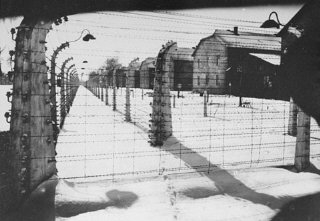 Never underestimate an abortion ideologue’s capacity for hypocrisy and detachment. In one of the sickest examples imaginable, Jezebel blogger Katie JM Baker profiles Gisella Perl, a Jewish gynecologist sent to Auschwitz in 1944 and forced to assist Josef Mengele. Baker hails Perl for “sav[ing] countless lives during the Holocaust.” How? By giving pregnant prisoners “undercover abortions with her bare hands.” From Perl’s entry at the Holocaust History Project:
Never underestimate an abortion ideologue’s capacity for hypocrisy and detachment. In one of the sickest examples imaginable, Jezebel blogger Katie JM Baker profiles Gisella Perl, a Jewish gynecologist sent to Auschwitz in 1944 and forced to assist Josef Mengele. Baker hails Perl for “sav[ing] countless lives during the Holocaust.” How? By giving pregnant prisoners “undercover abortions with her bare hands.” From Perl’s entry at the Holocaust History Project:
In an interview with Nadine Brozan for the New York Times in 1982, Dr. Perl recalled her initial experiences with Dr. Mengele’s “cure” for pregnancy in Auschwitz. ”Dr. Mengele told me that it was my duty to report every pregnant woman to him,” Dr. Perl said. ”He said that they would go to another camp for better nutrition, even for milk. So women began to run directly to him, telling him, ‘I am pregnant.’ I learned that they were all taken to the research block to be used as guinea pigs, and then two lives would be thrown into the crematorium. I decided that never again would there be a pregnant woman in Auschwitz.”19
After Dr. Perl’s startling realization of the fates of the pregnant women discovered by Dr. Mengele, she began to perform surgeries that before the war she would have believed herself incapable of – abortions. In spite of her professional and religious beliefs as a doctor and an observant Jew, Dr. Perl began performing abortions on the dirty floors and bunks of the barracks in Auschwitz “using only my dirty hands.”20 Without any medical instruments or anesthesia, and often in the cramped and filthy bunks within the women’s barracks, Dr. Perl ended the lives of the fetuses in their mothers’ womb (estimated at around 3,00021) in the hopes that the mother would survive and later, perhaps, be able to bear children.
In some instances, the pregnancy was too far along to be able to perform an abortion. In these cases Dr. Perl broke the amnionic sac and manually dilated the cervix to induce labor. In these cases, the premature infant (not yet completely developed), died almost instantly.22 Without the threat of their pregnancy being discovered, women were able to work without interruption, gaining them a temporary reprieve from their death sentences.
One of the little-discussed circumstances surrounding the issue of abortion in concentration camps was the fate of the infants who were not killed — along with their mothers — in the womb. In Auschwitz, infants were immediately killed through a variety of methods, both by Nazi and Jewish medical staff by “pinch(ing) and clos(ing)” the newborn’s nostrils and when it opened its mouth to breathe… gave it a dose of lethal product,” or drowning it in a pail of whatever liquid was available. The staff preferred this death to watching the child starve to death, according to Mengele’s orders.”23
Baker finds this “horrifying but also inspiring.”
If “inspiring” my stomach to send lunch back up counts, maybe.
Let’s analyze the situation: mother and child alike were both going to be killed anyway if the pregnancy was discovered. Leaving wasn’t an option. Freedom was nonexistent, and the perspectives of all involved were colored by living in hell on earth. Even if we concede that the abortions Perl performed were morally acceptable (which is still debatable), how would that make a case for abortion on demand? How would it possibly follow that it’s acceptable to kill a baby in circumstances where the mother faces no such risk, where she has other options, and where the baby will live?
Perl herself doesn’t seem to have thought it did. HHP says that because of her “professional and religious beliefs,” she would have found abortion unthinkable outside the death camps and quotes her as justifying her actions by noting that “two lives would be thrown into the crematorium” otherwise. After the war, she dedicated her life to Holocaust remembrance, infertility treatment, and delivering babies – not destroying them. The New York Times quotes her as saying, “No one will ever know what it meant to me to destroy those babies, but if I had not done it, both mother and child would have been cruelly murdered.” Perl never pretended they weren’t babies, that their lives didn’t matter, or that their deaths weren’t cruel.
Perhaps most grotesque is how Baker’s abortion dogma – and, we may safely surmise, that of the rest of Jezebel’s bloggers and a majority of their readers – is unfazed by the material she quotes. It’s bad enough whenever pro-aborts fail to draw lessons about devaluing human life from the Holocaust’s example, but here, Baker quotes language about “two lives” being present in pregnancy, and Perl “end[ing] the lives” of fetuses “using only my dirty hands.” Yet none of it sparks deeper reflection on what she and her colleagues’ cherished act consists of and takes away.
This is why we don’t look to champions of one holocaust to find understanding of another.







